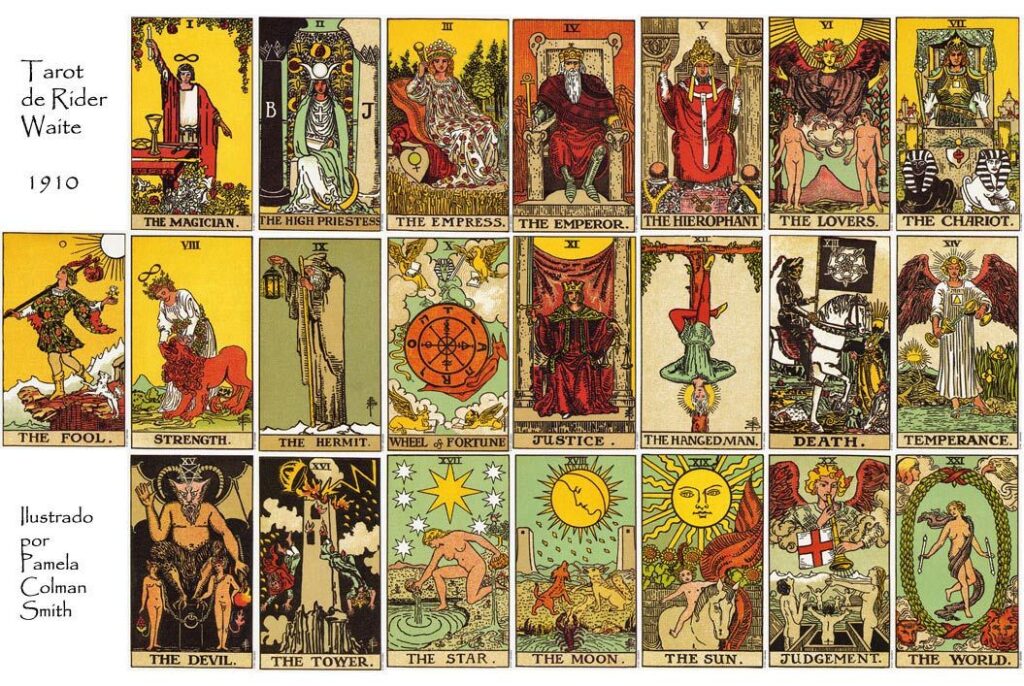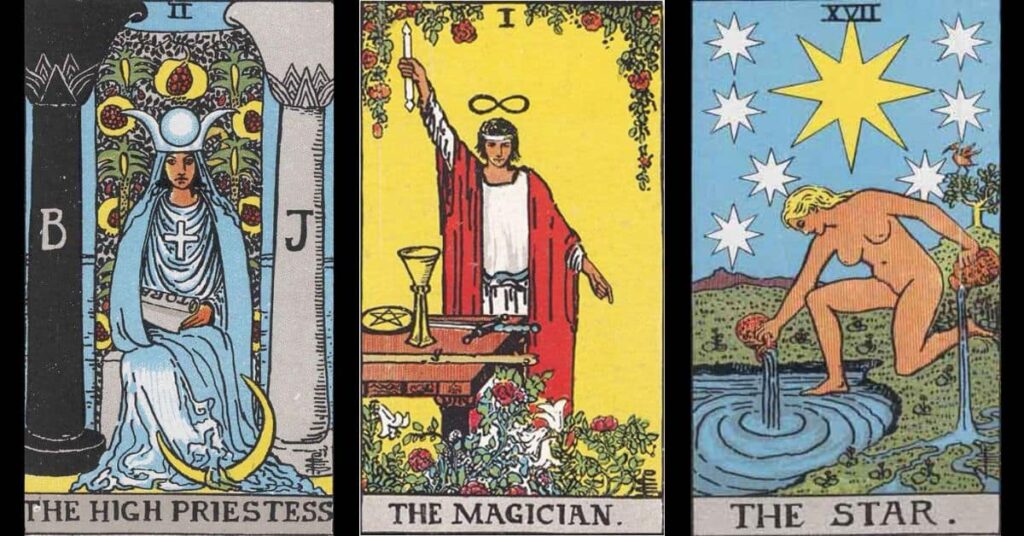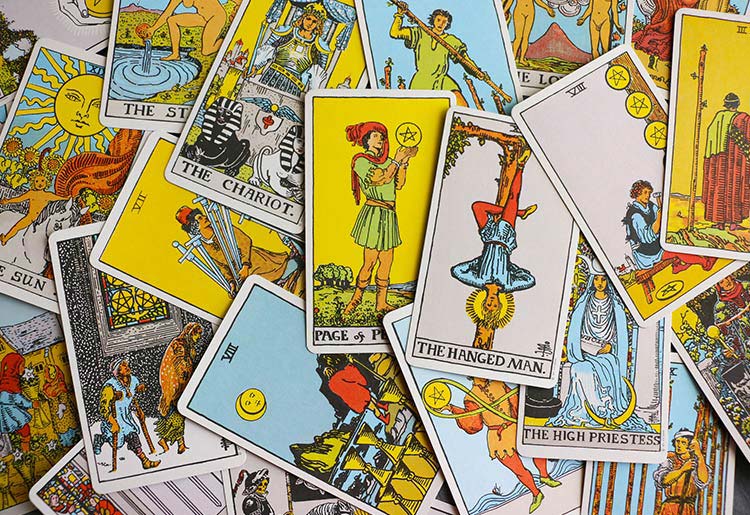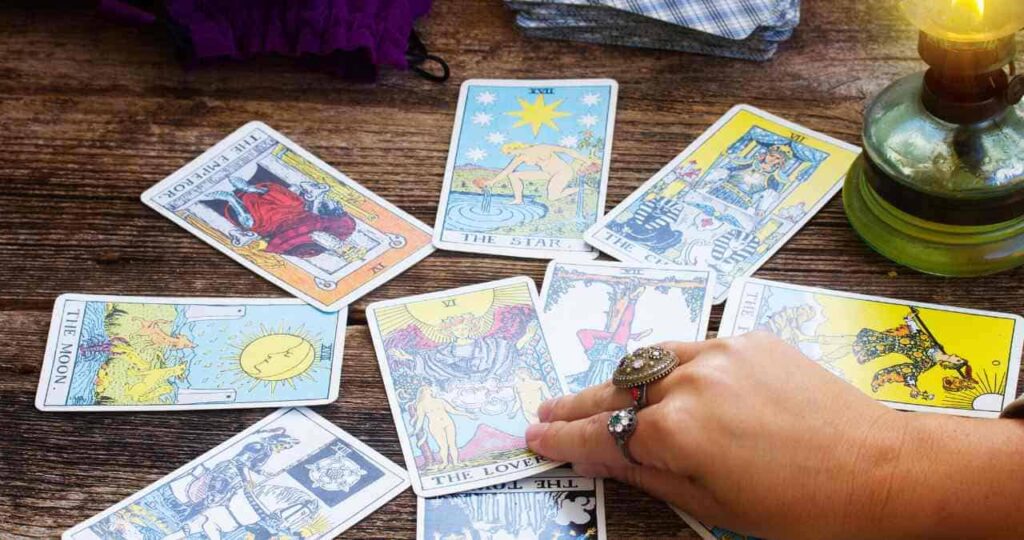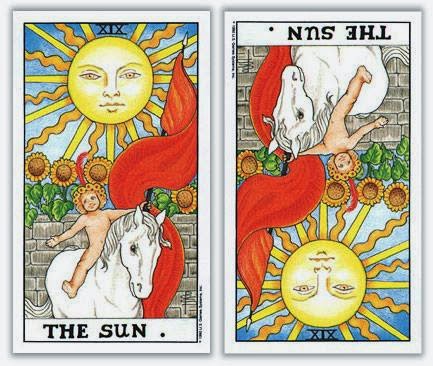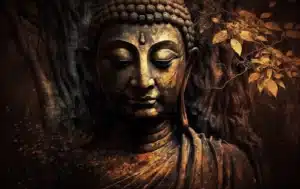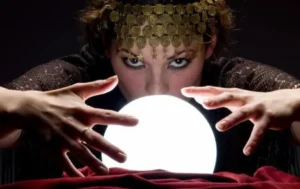The Major Arcana are very important cards in a Tarot deck. This remarkable collection of 22 cards is not only a collection of symbols, but also a living map representing human spiritual development and experience.
Major Arcana cards as a landmark or pivotal moment on the path of the so-called ‘Fool’s Journey’—a metaphorical voyage representing our shared voyage through life, from infancy to maturity, naivety to wisdom. As you draw each card, you’re tapping into centuries of wisdom, symbolism and spiritual insight. In the article, we will find out what the Major Arcana is, the meaning and how to read the cards in the Major Arcana!
What is Major Arcana?
The Major Arcana, a term stemming from the Latin word “Arcanus,” meaning secret or mystery, is an integral part of Tarot card deck, which is widely employed in various forms of divination and esoteric symbolism. It is composed of 22 cards, each one representing a particular archetypical concept or theme, embodying a diverse array of human experiences and spiritual lessons.
These cards stand out as the backbone of the Tarot deck and are often seen as more impactful in readings than the Minor Arcana, the remaining 56 cards, which correspond to more day-to-day, mundane aspects of life. The Major Arcana serves to delve into the profound questions of human existence and our overarching journey through life.
Beginning with The Fool (0 or 22, depending on the deck’s configuration) and culminating with The World (21), the sequence of the Major Arcana cards follows a narrative often referred to as “The Fool’s Journey”. This journey symbolizes the spiritual and psychological growth one undergoes throughout their life.
Each card in the Major Arcana encapsulates a symbolic figure or concept with multiple layers of meaning. For example, The Fool card typically signifies beginnings, potential, and the willingness to embark on new adventures, whereas The Magician represents manifestation, resourcefulness, and the power of the individual.
The interpretation of these cards is not static but rather fluid, subject to the context of the question asked and the intuition of the reader. This inherent flexibility and depth of interpretation allows the Major Arcana to serve as a powerful tool for introspection and self-understanding.
Furthermore, the Major Arcana has also been linked to various esoteric systems, including astrology, numerology, and the Kabbalah, thus reinforcing its role as an integrated system of symbols, deeply embedded within the Western esoteric tradition.
Symbolic meaning of Major Arcana cards
The Major Arcana, integral to the Tarot deck, comprises 22 individual cards each imbued with a unique array of symbolic meanings. These cards reflect key archetypes or universal aspects of human experience and spiritual growth.
- The Fool: Embodies potential, spontaneity, and the advent of a journey. The Fool can symbolize naivety but also the willingness to take risks and embrace the unknown.
- The Magician: Represents mastery, creativity, and the ability to transform thoughts into action. The Magician can indicate the harnessing of one’s skills and resources to manifest desires.
- The High Priestess: Symbolizes intuition, mystery and the divine feminine. She often represents the subconscious mind and the ability to understand the unseen.
- The Empress: Represents fertility, nurturing, and abundance. As a symbol of motherhood and nature, she signifies growth and the life-giving aspects of femininity.
- The Emperor: Symbolizes structure, control and authority. The Emperor signifies stability and leadership, often reflecting the patriarchal aspects of society.
- The Hierophant: Represents spiritual wisdom, tradition, and institutional structures. The Hierophant often symbolizes moral conscience and adherence to societal norms.
- The Lovers: Symbolizes love, unity, and choices. The Lovers represent harmony in relationships and often point towards important decisions or partnerships.
- The Chariot: Represents willpower, determination and control. The Chariot signifies the drive to overcome obstacles and achieve victory, symbolizing the harnessing of opposing forces.
- Strength: Symbolizes inner strength, courage, and compassion. The card suggests resilience and the power to overcome difficulties through inner resolve and gentleness.
- The Hermit: Represents solitude, introspection, and seeking inner wisdom. The Hermit often suggests a time for self-reflection or a quest for spiritual truth.
- Wheel of Fortune: Symbolizes the cycles of life, fate, and destiny. This card signifies the inevitability of change and the ebb and flow of fortune.
- Justice: Represents balance, fairness, and truth. Justice signifies the importance of ethical conduct and accountability.
- The Hanged Man: Symbolizes surrender, letting go, and gaining a new perspective. This card often suggests a period of pause, sacrifice, or seeing things from a different angle.
- Death: Represents transformation, endings and new beginnings. Despite its alarming imagery, the Death card signifies necessary change and the opportunity for rebirth.
- Temperance: Represents balance, patience, and moderation. Temperance suggests harmony and the blending of opposites to create a new whole.
- The Devil: Symbolizes temptation, bondage, and materialism. The Devil often points towards unhealthy attachments or a situation that hinders freedom and growth.
- The Tower: Represents sudden change, chaos, and revelation. The Tower signifies a dramatic upheaval that disrupts the status quo but ultimately leads to a clearer understanding.
- The Star: Symbolizes hope, healing, and renewal. The Star signifies inspiration and divine guidance, often serving as a beacon of optimism.
- The Moon: Represents illusion, intuition, and subconscious fears. The Moon signifies the realm of dreams, emotions, and the parts of ourselves that we keep hidden.
- The Sun: Symbolizes joy, success, and vitality. The Sun signifies abundance and positivity, often pointing towards achievements and personal fulfillment.
- Judgement: Represents rebirth, self-evaluation, and awakening. Judgement signifies a calling or realization that leads to significant change.
- The World: Symbolizes completion, accomplishment and integration. The World signifies the successful conclusion of a cycle or journey and the joy of achievement.
It should be noted that while this list provides a general interpretation for each card, the meanings can be fluid and often change based on the context of a reading, the position of the card within a spread, and the intuitive understanding of the reader. Furthermore, the sequence and numbering can vary slightly depending on the Tarot tradition or deck used, most notably in the case of the Strength and Justice cards, which are sometimes switched in position.
Uses of the Major Arcana in Tarot reading
In Tarot readings, The Major Arcana often considered the most powerful and profound section of the deck. Each card, from The Fool to The World, represents a distinct archetypal energy or spiritual lesson that can provide deep insight into various aspects of a querent’s life.
- Indicating significant life events and lessons: Unlike the Minor Arcana, which focuses on day-to-day matters, the Major Arcana represents larger themes and significant life events. These could range from major transitions and milestones to spiritual awakenings and profound realizations. For instance, The Fool might indicate a new beginning or an adventurous spirit, while Death often signifies a major transformation or the end of a particular phase in life.
- Guiding spiritual development: The Major Arcana also outlines the spiritual journey or the “Fool’s Journey,” which symbolizes the path from ignorance to enlightenment. As such, these cards can indicate where one is on their spiritual journey and suggest next steps for personal and spiritual development.
- Highlighting Archetypal Energies: Each Major Arcana card embodies a distinct archetype—a universal symbol or character that is part of the collective unconscious. These archetypes can shed light on the querent’s psyche, illuminating patterns of behavior, underlying motivations, or subconscious influences. For example, The Empress might indicate a nurturing, creative energy, while The Hermit often represents introspection and solitude.
- Providing major guidance: Given their weight in a Tarot reading, Major Arcana cards often offer significant guidance and advice. They might suggest actions to take, attitudes to adopt, or perspectives to consider. These cards can provide powerful insights and potential solutions to major challenges or dilemmas.
- Predicting major changes: Major Arcana cards in certain positions within a Tarot spread can predict significant changes or events in the querent’s future. These predictions often pertain to important aspects of life, such as personal growth, relationships, career, or spiritual development.
- Triggering self-reflection: The symbolic and archetypal imagery of the Major Arcana can provoke deep introspection, enabling the querent to explore their inner world and better understand themselves. This self-reflection can lead to self-awareness, personal growth, and transformation.
In essence, the Major Arcana serves as a mirror for the soul in a Tarot reading, reflecting significant life events, spiritual lessons, and underlying archetypal energies.
How to read Major Arcana cards
The process of reading the Major Arcana cards in a Tarot deck necessitates a keen understanding of the symbolic universe they encompass, a focused intuition, and an openness to the diverse interpretations they may inspire. Here are a series of steps to guide you in reading the Major Arcana cards.
- Familiarize yourself with the cards: Before conducting any Tarot reading, it is crucial to familiarize yourself with each of the 22 Major Arcana cards. Learn about the symbolic meaning, historical background, and common interpretations of each card. This foundational understanding will serve as a springboard for your intuitive insights during a reading.
- Set your intention and question: Tarot readings typically start with a question or intention. This could be a specific question about a situation or a general request for guidance. The nature of your question will significantly influence how you interpret the cards.
- Shuffle the cards: Mix the cards thoroughly while focusing on your question or intention. There are many ways to shuffle, and the best method is one that feels comfortable to you.
- Select your spread: A spread is a specific arrangement of cards, with each position in the spread representing a different aspect of the question. For beginners, a simple three-card spread representing past, present, and future can be a good starting point.
- Draw and place the cards: Draw the cards from the top of the deck or where you feel drawn to, and place them in the arrangement of your chosen spread. Remember to note whether the cards are upright or reversed, as this will influence their interpretation.
- Interpret the cards: Examine each card, its position in the spread, and how it may relate to your question. Consider both the traditional meanings of the cards and what your intuition is telling you about them. Remember, in the Major Arcana, cards represent major life events and spiritual lessons.
- Consider the interactions: Don’t just interpret each card in isolation. Consider how the cards interact with each other in the spread. Do they reinforce, challenge, or complement each other?
- Summarize the reading: After interpreting the individual cards and their interactions, summarize the overall message of the reading. This synthesis should directly address the question or intention you set at the beginning of the reading.
- Record your reading: It’s often helpful to record the details of your reading for future reference. This can assist in tracking patterns and themes over time and provides an opportunity for reflection.
Reading Major Arcana cards is a nuanced process that combines knowledge, intuition, and an openness to the myriad possibilities of symbolic interpretation. With practice and experience, the rich imagery and symbolism of the Tarot can provide meaningful insights and guidance.
The difference between Major Arcana and Minor Arcana
The Tarot deck comprises 78 cards, divided into two main sections: the Major Arcana and the Minor Arcana. Understanding the distinction between these two components is crucial for the study and practice of Tarot. Each Arcana serves different functions and carries different implications in a Tarot reading.
The Major Arcana consists of 22 cards, each one numbered and titled. These cards represent significant life events, spiritual lessons, and archetypal themes that reflect various stages of the human journey. The Major Arcana is often viewed as mapping out a path towards spiritual enlightenment, capturing the essence of human experiences and spiritual evolution.
On the other hand, Minor Arcana consists of 56 cards divided into four suits traditionally named Cups, Swords, Wands (or Rods), and Pentacles (or Coins). Each suit includes ten numbered cards (Ace through Ten) and four court cards (Page, Knight, Queen, and King). These cards mirror the structure of a regular playing card deck and are similar to it in many respects.
The Minor Arcana deals with the more mundane aspects of life, reflecting everyday events, circumstances, and behaviors. While the Major Arcana reflects overarching themes and profound life lessons, the Minor Arcana illustrates the details and specific instances within these broader narratives.
- Cups: Associated with the element of water, this suit often represents emotions, relationships, feelings, and creativity.
- Swords: Linked to the element of air, swords typically symbolize thoughts, intellect, conflict, and action.
- Wands: Tied to the element of fire, this suit often denotes inspiration, energy, passion, and personal growth.
- Pentacles: Associated with the element of earth, pentacles usually represent material aspects of life such as wealth, work, and physical health.
In a Tarot reading, the Major Arcana cards usually indicate significant life events or changes, or spiritual lessons that are at play, while the Minor Arcana cards tend to refer to the day-to-day events, feelings, thoughts, and actions that occur within these broader themes. Together, they provide a comprehensive tool for divination and self-reflection, each contributing to a complete picture of the complexities of human life and spiritual progression.
What are reversed Major Arcana cards?
In the practice of Tarot reading, a card can appear in two orientations: upright or reversed. When a Tarot card is flipped and it appears upside down, it is said to be in its reversed position. A reversed Major Arcana card has its own unique set of meanings distinct from its upright counterpart. The phenomenon of card reversal introduces a deeper layer of complexity and nuance to a Tarot reading, expanding the range of potential interpretations.
Interpretation of reversed Major Arcana cards depends largely on the specific tradition or methodology of the reader. Generally, a reversed Major Arcana card can indicate one or more of the following:
- Blocked or resisted energy: In this perspective, a reversed Major Arcana card suggests that the energy of the card is present but is being blocked or resisted in some way. For instance, the reversed Strength card might indicate that the querent is struggling to find courage or patience in their situation.
- Internalization: Reversed cards can also signify that the energy of the card is being internalized. For example, the reversed Hermit could suggest a period of self-reflection or inner search.
- Excess or imbalance: Another interpretation posits that a reversed card indicates an overabundance or imbalance of the aspects symbolized by the card. A reversed Chariot, for example, could suggest excessive determination leading to ruthless behavior.
- Negative or opposite meaning: Some readers interpret reversed Major Arcana cards as signifying the negative or opposite meaning of the upright card. For instance, the reversed Empress may denote dependency or a lack of growth.
- Past influence: In some cases, reversed cards may also indicate a past influence or situation that is still impacting the present.
Notably, not all Tarot readers use reversed cards in their readings. Some readers prefer to interpret all cards in their upright position and rely on the surrounding cards and their intuition for negative aspects.
Ultimately, the interpretation of reversed Major Arcana cards, much like Tarot reading in general, is highly dependent on the reader’s intuition, experience, and preferred methodology. It’s crucial to approach each card with an open mind and a willingness to explore the multifaceted symbolism that the Tarot offers.
Can Tarot reading with only Major Arcana cards?
Yes, conducting a Tarot reading with only the Major Arcana cards is not only possible but is a recognized practice known as a Major Arcana-only reading. This form of reading can provide a focused perspective on the querent’s spiritual journey, highlighting significant life events, major transitions and essential life lessons.
A Major Arcana-only reading works much like any other Tarot reading, and it can be performed using a variety of spreads, from a simple single-card draw to more complex arrangements like the Celtic Cross. The difference lies in the removal of the Minor Arcana cards from the deck before shuffling and drawing the cards.
There are several reasons why one might choose to perform a Major Arcana-only reading:
- Focus on major life events: The Major Arcana represents significant life events, transitions, and spiritual lessons. Therefore, a Major Arcana-only reading may be particularly appropriate when the querent is undergoing major life changes or seeking guidance on big life decisions.
- Spiritual and psychological exploration: Given the archetypal and spiritual themes embodied in the Major Arcana, this type of reading can be helpful for those who wish to delve deeply into their inner psychological states or spiritual journey.
- Simplicity and focus: For beginners learning Tarot, focusing on the 22 Major Arcana cards can simplify the process, allowing for a deeper understanding of each card’s fundamental meanings before moving on to the more nuanced interpretations required by the inclusion of the Minor Arcana.
However, while a Major Arcana-only reading can provide profound insights, it’s important to remember that it does not provide the more detailed, mundane, and practical guidance often offered by the Minor Arcana. The Major Arcana may paint the broad strokes of a person’s life, but the Minor Arcana fills in the finer details.
In conclusion, a Tarot reading with only the Major Arcana cards can indeed be performed and may be particularly suited to addressing significant life changes, deep spiritual questions, and broad themes of personal development. However, for a comprehensive understanding of the querent’s situation, including both the Major and Minor Arcana might be beneficial.
You can also refer more:
- How to choose the right Tarot deck: https://lotusbuddhas.com/how-to-choose-the-right-tarot-deck.html
- The meaning of Reversed Tarot Cards: https://lotusbuddhas.com/the-meaning-of-reversed-tarot-cards.html
- The different types of Tarot decks: https://lotusbuddhas.com/the-different-types-of-tarot-decks.html


